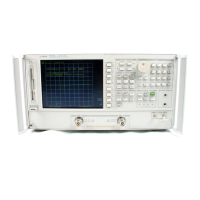Scale Reference Menu
The
@GiZGTj
key provides access to the scale reference menu.
Softkeys
within this menu can
be used to
define
the scale in which measured data is to be displayed, as well as simulate phase
offset and electrical delay. The following softkeys are located within the scale reference menu.
Electrical Delay
The
~T~~~~~~~
softkey
adjusts the electrical delay to balance the phase of the test
_
_
_
_
/.A
. . . . . .
. . . . .
\....i...........;
. . . . . . . . . . .
;..;......;..
. . . . ;a;.
. . . ...v
. .
I.
I.
../
device.
l’l-&
softkey
mu&
be
used
h
conjjun&ion
with
~~~~~~.~~~~~
or
~~~~~~~~~~
(with cut-off frequency) in order to identify which type of transmission line the delay is being
added to.
Electrical delay simulates a variable length
lossless
transmission line, which can be added to or
removed from a receiver input to compensate for interconnecting cables,
etc.
This function
is similar to the mechanical or analog “line stretchers” of other network analyzers. Delay is
annotated in units of time with secondary labeling in distance for the current velocity factor.
_ _
_
_
.,.
.,.,.,.,.,.,.,.,.,.,.
Witi
this
featwe,
and
dti
~~~~~~~
(see
“Using
Markers”),
a
equivalent
length
of
./........................................~~........~~....
i.
.
.
..i
. . . . . . .
\
.;::..::
:::......;
..
.
.
.
.
.
.
.
.A..
.vu......>
..
.
..v
.w..
.A..
i
air-filled,
lossless
transmission line is added or subtracted according to the following formula:
Length (meters) =
(Freq
(MHf)
x
1.20083)
Once the linear portion of the test device’s phase has been removed, the equivalent length of
the lossless, transmission line can be read out in the active marker area. If the average relative
permittivity
(e,)
of the test device is known over the frequency span, the length calculation can
be
adjusted
to indicate the actual length of the test device more closely. This can be done by
entering the relative velocity factor for the test device using the calibrate more menu. The
relative velocity factor for a given dielectric can be calculated by:
Velocity Factor =
1
A
assuming a relative permeability of 1.
Appliwtion and Operation Concepts
641

